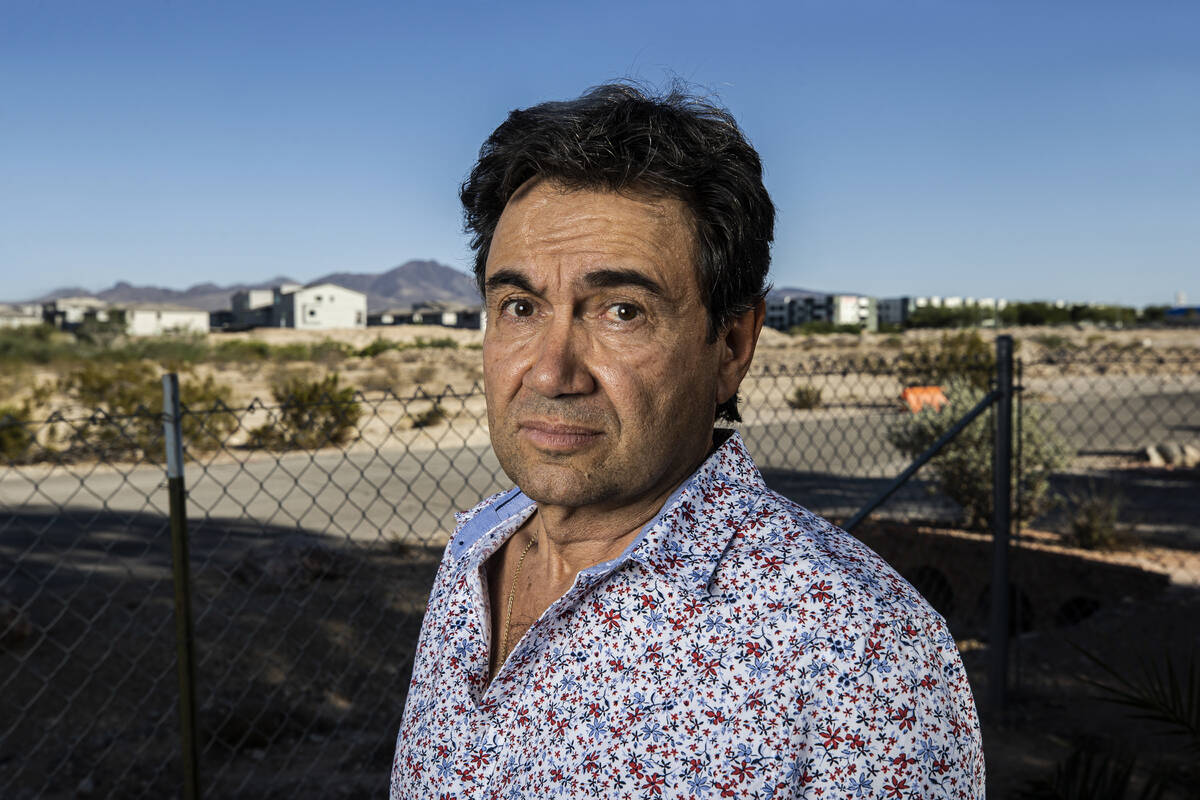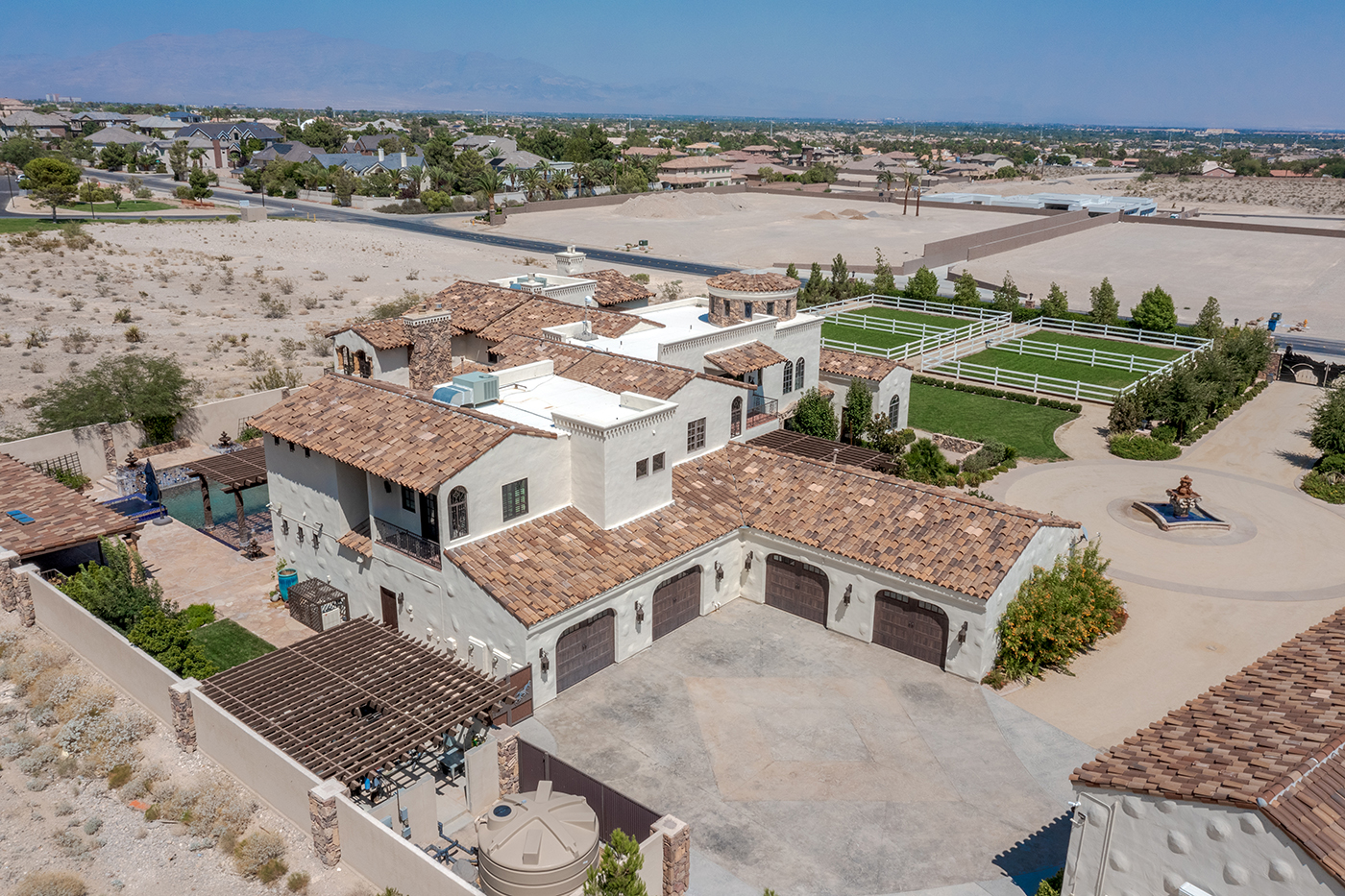From the front passenger seat, Biagio Guerra drives through his community far south in the Las Vegas Valley and points with a disdain for high-density apartments that provide insights into his career in the architecture and construction industry.
Guerra criticized builders for building projects that he said should maximize homes per acre and profit.
“I mean, look, there is no respect for other people’s property,” he said. “You just pop that cubic foot in and get as much money as possible. Hit and run. It’s called Hit and Run. “
Guerra, 63, on Monday toured the unincorporated area near Liberty High School that he has called home for nearly three decades, complained that denser housing is creeping into the rural community where ranch houses were once open large plots ruled.
He belongs to a contingent of neighbors who are against the latest project that would creep into their landscape protection area designated by the district: a proposal to develop 22 single-family houses on seven hectares.
The plan is inconsistent with permissible zoning, which requires homes to be built on lots no smaller than half an acre. Pulte Homes, the developer, is aiming for a zone change.
After the development was approved by the planning commission 5: 2 last month, despite the rejection by the Enterprise Town Advisory Board in July, the neighbors for and against the project now await its fate in front of the district legislators during the meeting of the building commission on Wednesday.
Pulte Homes has vowed to build single story homes only, and some of the neighbors closest to the proposal say they support it as a less undesirable alternative to taller homes that could secure their lots. But in the run-up to the planning commission’s hearing, several dozen protest cards and opposition letters were submitted.
“Why do we have to change?” asked the local resident Jerry Pavelec during the meeting. “So we’re fighting now.”
Pavelec and Guerra said they were not against the growth, they just wanted the zoning to be followed. The county master plan discourages non-compliant zone changes, and the county employees recommend rejecting the project, according to a county report.
Precedents, floods worry neighbors
In an interview on Monday, Guerra and Pavelec said they had collected between 150 and 200 signatures from neighbors against the project, which is located on the southeast corner of Chartan Avenue and Placid Street and just inside the rural neighborhood.
The official name is intended to protect the rural area, which is characterized by single-family houses on large plots and in some cases riding facilities. According to the Enterprise Land Use Plan adopted in 2014, it is intended to prevent “more intensive development” from penetrating the area.
Opponents say higher density homes won’t fit in the area, and they fear the project’s approval would open the door to other landowners in the designated rural area to look for similarly overcrowded projects.
Pulte Homes had approved a 58-house project south of its current proposal in 2019, according to Guerra, who lives down the street on the 22-house plan due to be considered Wednesday. Further suburban residential developments have been approved or built in the vicinity.
Jodi Collins told planners last month that she has lived in the area for 14 years and moved there specifically for the rural lifestyle.
“But we are constantly facing builders who want to move to a higher density of housing,” she said, adding that the buffer between maintaining the rural neighborhood and urban development is constantly changing. “So it’s getting closer and closer to my house.”
Opponents also worried about flooding, saying water drainage issues were getting worse and had not been adequately addressed. Many homes in the area rely on wells that need to be replenished from rain seeping into the ground, they say. According to John Sullivan, a lawyer representing Pulte Homes, a wash is running through the western portion of the top lot of the proposed development.
According to the applicant, “this project will have no negative impact on public facilities and will in fact solve a long-standing drainage problem that is causing flooding in the area,” the district staff report shows.
Respond to concerns
Sullivan told planners last month that the developer had made a number of changes to their plan since the first neighborhood meeting a few months ago. Each lot will be over 10,000 square feet and traffic will be diverted out of the rural neighborhood sanctuary, he said.
In addition, a solid wall along Chartan Avenue and Placid Street will be embellished with trees and shrubs, and a four-foot tall, 18-foot wide box culvert will provide drainage, he said.
Ultimately, according to Sullivan, the project will be as harmless as possible in rural areas.
The concessions turned opponents in the immediate vicinity of the project into supporters, even if members of the extended rural neighborhood protection area seem to be against it.
“You have that balance between what’s more important?” Sullivan told the planning committee. “The plots that are hardest hit and that are most closely adjacent to this plot of land? Or is it a collective census among everyone in the (rural neighborhood protection zone)? “
Better as a possible alternative
Planners said they were convinced of the property’s month-long efforts to address neighbors’ concerns, although Guerra and Pavelec said Monday they had evidence that more neighbors closest to the project oppose it than support it.
Commissioners Jenna Waltho, who represents the region, and Duy Nguyen were the only ones who had no votes for the project last month.
Sherry Outlaw, who lives next to the planned construction project, informed the planning committee that two- and three-story houses would be built if the planned project were not adhered to and traffic came directly to their gate.
“We’re absolutely scared it’s all to us,” said Outlaw. “We want (rural neighborhood preservation) but there is no RNP. We’re going to get a bloody development across the street no matter what we do. “
Contact Shea Johnson at sjohnson@reviewjournal.com or 702-383-0272. Follow @Shea_LVRJ on Twitter.



/cloudfront-us-east-2.images.arcpublishing.com/reuters/OXAEBQRHDJIDPH6GON4LR5ROOU.jpg)









